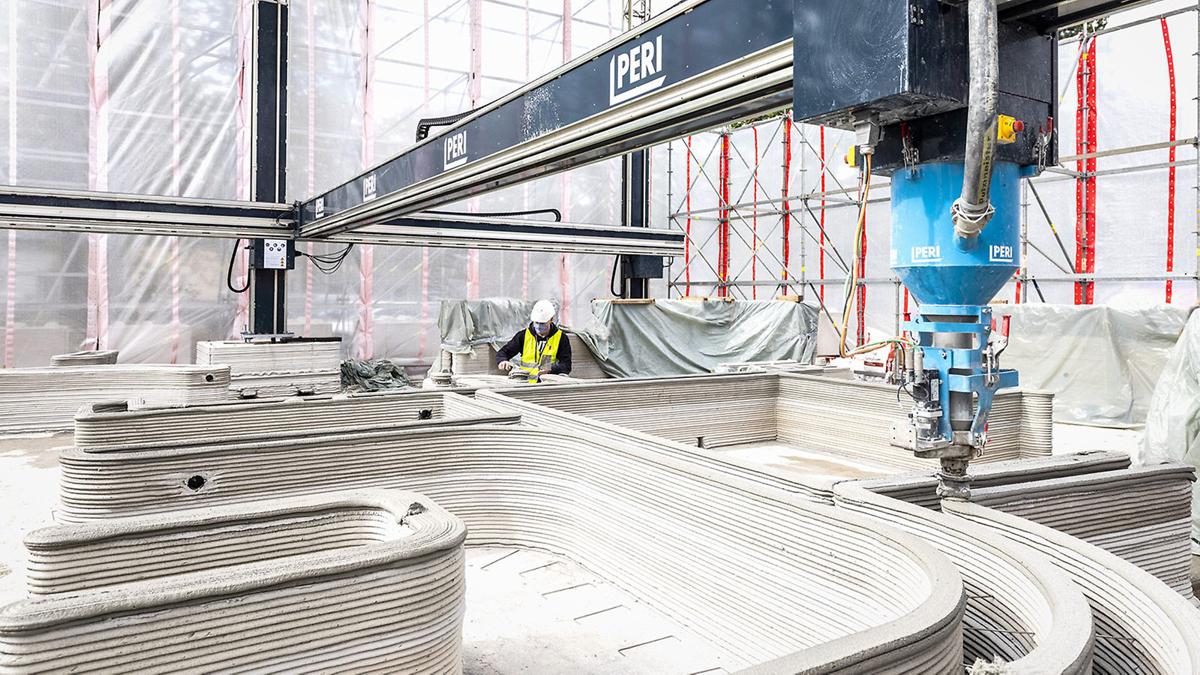PERI 3d prints the first residential building in Germany
PERI GmbH is building Germany’s first 3D-printed residential building in Beckum, North Rhine-Westphalia. The two-storey detached house with approx. 80 sqm of living space per floor is not being constructed in the conventional manner, it is being printed by a 3D construction printer.
This construction technique, which is being put into practice in Germany for the first time, has come through all of the regulatory approval processes over the last few weeks and months. The engineering office Schießl Gehlen Sodeikat supported the development of the concept for obtaining the approval, the planning and execution of the corresponding approval tests was carried out by the Technical University of Munich.The building was planned by MENSE-KORTE ingenieure+architekten and the client is Hous3Druck GmbH. The materials used to produce the printable concrete are being sourced from HeidelbergCement.
The federal state of North Rhine-Westphalia is supporting the 3D construction printing project in Beckum as part of its “Innovatives Bauen” (innovative construction) development scheme. Today, Ina Scharrenbach, Minister for Regional Identity, Communities and Local Government, Building and Gender Equality in the federal state of North Rhine-Westphalia, was briefed on the current state of affairs at the construction site in Beckum.
“North Rhine-Westphalia innovation for Germany: digital, dynamic, ready to print – these are our keywords for the future of construction. We are proud that the first house to be 3D printed is being built in our federal state. This makes North Rhine-Westphalia a pioneer for Germany. Not tomorrow, not some day, but today. The state government of North Rhine-Westphalia is providing specific support for investments in the innovation engine of construction: the 3D house is being subsidized with €200,000. Further projects are in the printing loop,” explains Scharrenbach.
“The construction of the 3D-printed residential building in Beckum is a milestone for 3D construction printing technology,” says Thomas Imbacher, Innovation & Marketing Director at PERI GmbH. “We are very confident that construction printing will become increasingly important in certain market segments over the coming years and has considerable potential. Other residential printing projects are now being drawn up in Germany. We are proud that PERI’s involvement in the project in Beckum has seen us become a pioneer and forerunner for this new construction technique.”

“At PERI, we see ourselves as a leading innovator in our markets,” says Dr Fabian Kracht, Finance & Organisation Director and Spokesperson of the PERI Group management board. “Investing wisely in start-ups that are offering new solutions in our markets is another aspect of that. 3D printing is a business segment that has emerged from this investment portfolio and has now made its way onto the market. The success story in Beckum is validation that we have taken the right approach.”
“3D construction printing fundamentally changes the way we build and the process of residential construction. As this is the first building of its kind, we are making a point of printing at a slower rate than what is actually possible,” says Leonhard Braig, Production & Supply Chain Director at PERI GmbH. “We want to take the opportunity to gain further experience in day-to-day operations as this will help us to leverage the cost reduction potential of our technology to a greater extent in the next printing project.”
The building was planned by MENSE-KORTE ingenieure+architekten and the client is Hous3Druck GmbH. “The concrete printing process affords us designers a high degree of freedom when we are designing buildings. With conventional construction methods, this would only be possible at great financial cost,” says architect Waldemar Korte, partner of the architectural practice MENSE-KORTE ingenieure+architekten in Beckum. “With our printed residential building in Beckum, we are demonstrating the potential of the construction printing process. It is a huge privilege for our team to realise the first 3D-printed residential construction project in Germany. We believe in the future viability of construction printing technology for the construction sector and already have other 3D printing projects on our radar.”

Printing technology and materials
PERI uses 3D printers of type BOD2 for printing. This printing technology comes from the Danish manufacturer COBOD. PERI acquired a stake in COBOD back in 2018. The BOD2 printer used in Beckum is a gantry printer, which means that the print head moves about 3 axes on a securely installed metallic frame. The benefit here is that the printer can move along its frame to any position within the construction and only needs to be calibrated once.
The “i.tech 3D” material used in the printing process was developed by HeidelbergCement specifically for 3D printing. Its properties are tailored to the specific requirements of 3D construction printing and it works perfectly with the BOD2 printer. This ensures that consistent progress is made throughout the construction project.
“We had an efficient and innovative collaboration with HeidelbergCement. They have been instrumental in clarifying all outstanding questions regarding construction methods and printing materials quickly and easily,” says Fabian Meyer-Brötz, Head of 3D Construction Printing at PERI.
The building consists of triple-skin cavity walls, which are filled with an insulating compound. During the printing process, the printer takes into account the pipes and connections for water, electricity, etc. that are to be laid at a later time. The BOD2 has been certified in such a way that it is possible to carry out work within the printing area while printing is in progress. This means that manual work, such as the installation of empty pipes and connections, can be easily integrated into the printing process.
Only two operators are required to run the printer. The print head and the print results are monitored by a camera. With a speed of 1 m/s, the BOD2 is currently the fastest 3D construction printer available on the market.
The BOD2 only takes around 5 minutes to complete 1m² of a double-skin wall.




















